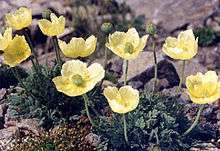Papaver nudicaule
| Iceland poppy | |
|---|---|
 | |
| Scientific classification | |
| Kingdom: | Plantae |
| (unranked): | Angiosperms |
| (unranked): | Eudicots |
| Order: | Ranunculales |
| Family: | Papaveraceae |
| Genus: | Papaver |
| Species: | P. nudicaule |
| Binomial name | |
| Papaver nudicaule L.[1] | |
Papaver nudicaule (syn. Papaver croceum, P. miyabeanum,[2][3] P. amurense, and P. macounii), the Iceland poppy,[4] is a boreal flowering plant. Native to subpolar regions of Europe, Asia and North America, and the mountains of Central Asia[5] (but not in Iceland), Iceland poppies are hardy but short-lived perennials, often grown as biennials, that yield large, papery, bowl-shaped, lightly fragrant flowers supported by hairy, one foot, curved stems among feathery blue-green foliage 1-6 inches long. They were first described by botanists in 1759. The wild species blooms in white or yellow, and is hardy from USDA Zones 3a-10b. All parts of this plant are likely to be poisonous,[6] containing (like all poppies) toxic alkaloids. In particular, P. nudicaule has been shown to contain the benzophenanthidine alkaloid, chelidonine.[7] It also contains (+)-amurine, (-)-amurensinine, (-)-O-methylthalisopavine, (-)-flavinantine and (-)-amurensine.[8]
Varieties
Cultivars come in shades of yellow, orange, salmon, rose, pink, cream and white as well as bi-colored varieties. Seed strains include: ‘Champagne Bubbles’ (15-inch plants in orange, pink, scarlet, apricot, yellow, and creamy-white); ‘Wonderland’ (10-inch dwarf strain with flowers up to 4 inches wide); ‘Flamenco’ (pink shades, bordered white, 1½ to 2 feet tall); ‘Party Fun’ (to 1 foot, said to bloom reliably the first year in autumn and the second spring); ‘Illumination’ and ‘Meadow Pastels’ (to 2 feet, perhaps the tallest strains); ‘Matador’ (scarlet flowers to 5 inches across on 16 inch plants); the perennial 'Victory Giants' with red petals and ‘Oregon Rainbows’, which has large selfed, bicolor, and picoteed flowers and is perhaps the best strain for the cool Pacific Northwest[9] (elsewhere this strain’s buds frequently fail to open).
Cultivation
The plants prefer light, well-drained soil and full sun. The plants are not hardy in hot weather, perishing within a season in hot summer climates.
Iceland poppies, like all poppies, possess exceedingly minute seeds and long taproots that resent disturbance. In cool summer climates on well-drained soils, Iceland poppies can live 2-3 seasons, flowering from early spring to fall.[10]
Iceland poppies are amongst the best poppies for cutting, as they last for several days in the vase.
Genetics
The genetics of the garden forms of P. nudicaule have been studied, particularly with respect to flower colour.[11] The white flower colour is dominant with respect to yellow. Other colours, such as buff and orange, are recessive.
References
| Wikimedia Commons has media related to Papaver nudicaule. |
- ↑ Linne, Carl von (1753). Species Plantarum. Holmiae :Impensis Laurentii Salvii. p. 507.
- ↑ "''Papaver nudicaule'' - Flora of Pakistan". Efloras.org. Retrieved 2014-04-27.
- ↑ John H. Wiersema (2005-02-22). "Genus ''Papaver'' - GRIN taxonomy". Ars-grin.gov. Retrieved 2014-04-27.
- ↑ "BSBI List 2007". Botanical Society of Britain and Ireland. Archived from the original (xls) on 2015-02-25. Retrieved 2014-10-17.
- ↑ John H. Wiersema. "''Papaver nudicaule'' - GRIN taxonomy". Ars-grin.gov. Retrieved 2014-04-27.
- ↑ Kingsbury, J. M. (1964) Poisonous plants of the United States and Canada. Prentice-Hall Inc., Englewood Cliffs, N.J., USA. pp. 626
- ↑ Zhang, Y., Pan, H., Chen, S., Meng, Y., Kang, S. (1997). [Minor alkaloids from the capsule of Papaver nudicaule L.] Zhongguo Zhong Yao Za Zhi 22: 550-1, 576. In Chinese.
- ↑ Philipov, S; Istatkova, R; Yadamsurenghiin, GO; Samdan, J; Dangaa, S (2007). "A new 8,14-dihydropromorphinane alkaloid from Papaver nudicaule L". Natural product research. 21 (9): 852–6. doi:10.1080/14786410701494777. PMID 17763104.
- ↑ Sunset Publishing (2001) Sunset Western Garden Book, ed. 7 (Sunset Books Incorporated: ISBN 0-376-03874-8)
- ↑ Armitage, Allan M. (2001) Armitage’s Manual of Annuals, Biennials, and Half-Hardy Perennials (Timber Press; ISBN 0-88192-505-5)
- ↑ Fabergé, A.C. (1942) Genetics of the scapiflora section of Papaver 1. The Garden Iceland Poppy. Journal of Genetics 44: 169-193.




